
More About Google’s Automated Bidding Strategies
• What is automated bidding?
• The difference between manual and automated bidding
• The benefits of using automated bidding in Google Ads
• The pros and cons of Google Ads’ 9 bidding strategies
• Conclusion
What is Automated Bidding?
Automated bidding is a subset of automated bid strategies in Google Ads. Powered by advanced machine learning, the automated bidding feature factors in a wide range of signals, such as device, location, time of day and language to capture the unique context of every search. Using this information, it tailors the right bid to each auction.
Each type of automated bid strategy is designed to help you achieve a specific goal, whether it is to get views, impressions, clicks or conversions.
Automated bidding and Smart Bidding often get used interchangeably, but they’re not the same thing. Smart Bidding only includes Google’s automated bid strategies that use “auction-time bidding” and that optimise for conversion or conversion value. These include:
• Enhanced CPC
• Maximise Conversions
• Maximise Conversion value
• Target CPA
• Target ROAS
To sum it up: All Smart Bidding strategies are automated, but not all automated bidding strategies are Smart Bidding strategies.
The Difference Between Manual Bidding and Automated Bidding
When you set up a Google Ads campaign, you have to let Google know how much you’re willing to pay for your ad to be displayed or clicked on. This is called your bid. There are two different ways to set your Google Ads bids: manual or automated.
Manual CPC bidding lets you set your own maximum cost-per-click (CPC) at keyword level for your Google ads. With manual bidding, can adjust your bids depending on location, device, demographics, and your ads’ performance. This means that you have control over the maximum cost for each click on your ads.
With automated bidding, Google uses automated rules to adjust your bids for you. It does this by using additional data points to calculate the ads’ likelihood of getting a click or conversion.
If you’re running a lot of different PPC ads, manual bidding can become a time-consuming, complex task and automated bidding might be more efficient.
The Benefits of Using Automated Bidding in Google Ads
Here are a couple of reasons why you may consider an automated bidding strategy.
1. Save time
PPC advertising is a lot more complex than it used to be a decade ago. Traditionally, PPC advertisers simply had to do keyword research, choose a set of keywords, write ad copy for those keywords and then set the right bid for each keyword.
Fast-forward ten years and we have so many more moving parts in Google Ads. With myriad social platforms and ad networks, the user journey and conversion path have become a lot more complicated. This is true for both the consumer journey and the B2B marketing funnel.
To give you an idea of the complexity, here are some of the factors that determine how profitable a keyword will be:
• Device
• Time of day
• Day of week
• Location
• Operating system
• Interest
• Language
• Demographics
• Browser
• Search network partner
• Ad and extensions
With all of this added complexity, one needs to take a lot into consideration to set a bid that is right for the specific auction – and there’s only so much that a human can process and handle.
Automated bidding can process all this information and set a bid that is right for the specific auction in real-time – something that a human would not be able to do. What’s more, there’s no need to manually update bids for specific ad groups or keywords, which also helps to save time.
2. Take the guesswork out of reaching performance goals
Google Ads’ advanced automatic bidding algorithm does all the heavy lifting for you. Using advanced machine learning algorithms to train on a wide range of data points, automated bidding optimises your future bids – giving you better results without you having to lift a finger. These algorithms factor in a wider range of performance-impacting parameters that a single person or team could compute.
The Pros and Cons of Google Ads’ 9 Automated Bidding Strategies
Google Ads offers several bid strategies that are tailored to different types of PPC campaigns. Depending on which networks your campaign is published and whether you want to focus on getting impressions, views, clicks or conversions, you can determine which bidding strategy is best for you.
So how do you determine a bidding strategy that’s based on your goals? Below is a list of Google Ads’ nine automated bidding strategies, and each one’s pros and cons.
- Enhanced cost per click (eCPC)
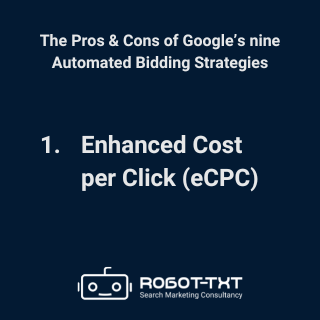
Enhanced CPC bidding is a semi-automated bidding strategy that allows the Google Ads algorithm to make adjustments to your manually set keyword bids, based on the likelihood of a click leading to a sale.
Pros of Enhanced Cost Per Click
• The best of both worlds
The Enhanced CPC automated bidding strategy gives you the best of both manual and automated bidding: It gives you the control of setting your bids manually and the benefits of Google Ads Smart Bidding.
• More traffic and conversions
eCPC is a very effective strategy in increasing click-through rate (CTR), which means more traffic to your landing page, as well as increasing conversion rate (CVR).
• Beginner-friendly
Very similar to manual bidding, eCPC is a good first step into automated bidding.
Cons of Enhanced Cost Per Click
• Higher CPA
With this bid type, Google’s algorithm tends to raise the bid more often than lowering it, in order to increase the likelihood of a conversion. However, it might not necessarily target the cost per action (CPA) you have in mind.
Additionally, Enhanced CPC can adjust keyword bids with no limits in place. All of these factors increase the possibility that bids, and resulting cost per clicks, could be too high to make the ad campaign profitable.
• You need to monitor results closely
To see if the bidding strategy is functioning as expected, a close eye should be kept on click-through rate and conversion rate (both should go up). However, you also need to track cost per click and cost per conversion to ensure the campaign is still profitable. - Maximise Clicks
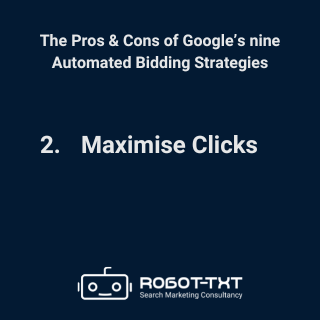
With the Maximise Clicks bidding strategy, Google will aim to get as many clicks as possible while spending your daily budget.
Pros of Maximise Clicks
• Good for brand building and increased traffic
The Maximise Clicks bidding strategy can be great if you’re trying to drive more traffic to your site, whether it’s for brand building or PPC remarketing list-building purposes. This strategy can be especially effective if you have very strong conversion performance on your landing page.
• Control over cost per clicks
You can set a maximum cost per click limit to help keep costs down while Google gets you more clicks.
• No tracking required
You don’t need to set up conversion tracking to start this strategy. You can start immediately with no data.
• Great for Google Ads beginners
Opposed to the more advanced bidding strategies, Maximise Clicks is great for beginners in learning the PPC advertising process before switching to other advanced bidding strategies.
Cons of Maximise Clicks
• Clicks do not necessarily get profitable results
Unlike bidding strategies like Target CPA or Target Return on Ad Spend (ROAS), which focus on results like conversions and revenue, Maximise Clicks cannot guarantee bottom line-impacting results. This is because it’s not clear what is going to happen after someone clicks your ad.
• You can’t bid effectively on competitive keywords
With this strategy, advertisers often limit their maximum CPC. As a result, it’s more difficult to participate in auctions for competitive keywords.
• Irrelevant clicks
As the Maximise Clicks strategy only focuses on bringing in clicks, there is a possibility that some clicks won’t be relevant to your business; especially when using certain broad match keywords.
• No bid adjustments available for date and time
According to Google support, the Maximise Clicks bidding strategy doesn’t have bid adjustments for time and date. This can be a disadvantage during times when businesses don’t operate, or during the times of day or week when the chance of making a sale is very low. - Maximise Conversions
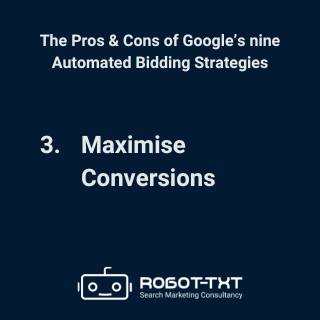
Maximise Conversions is similar to Maximise Clicks but instead focuses on conversions. This fully automated bidding strategy chooses a cost per click bid, based on the goal – to get as many conversions as possible within the limits of your daily budget.
Pros of Maximise Conversions
• Higher ROI
While the Max Conversions bidding strategy has a history of spending more aggressively, the increased number of conversions may balance out the higher CPC. Even though your ad spend, or average cost per click, may be higher, you’ll have more conversions, resulting in an overall lower cost per action and higher ROI.
• Added control over CPA
As of April 2021, the Max Conversions bidding strategy also lets you add a target cost per action/conversion to guide the bidding to be more in line with your budget limits.
• Great for lead generation
If your goal is to generate leads at more affordable rates, Maximum Conversions is a great bidding strategy.
Cons of Maximise Conversions
• Could be more costly with shared budgets
The Maximise Conversions bidding strategy will always aim to spend the full allocated daily budget per campaign. You therefore need to ensure each campaign has its own daily budget assigned, rather than having a shared budget. This will ensure you have more control over how much is spent per campaign and that the money is spent more equally among campaigns.
• You need to set up conversion tracking
In order for the Maximise Conversions algorithm to make the best decisions, you need to have conversion tracking in place. - Maximise Conversion Value
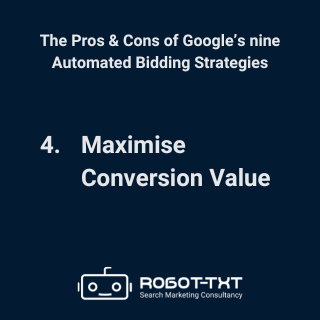
Available on Google Paid Search, Shopping and Display ads, the Maximise Conversion Value bidding strategy is slightly more advanced than it’s younger sibling, Max Conversions. The difference being that Maximise Conversion Value optimises for conversions based on revenue metrics, like sales revenue or profit margins. Here, it’s all about quality over quantity.
Pros of Maximise Conversion Value
• Set a Target ROAS
Similar to how the Maximum Conversions bidding strategy allows you to set a Target CPA, Max Conversion Value enables you to set a Target ROAS to help guide its bidding. This can help you optimise your profits.
• Use bid adjustment to reach higher value customers
You can set bid adjustments to show your ads more or less frequently based on where, when and how people search. You can also adjust your conversion values with conversion value rules for higher value types of customers, devices or locations.
Cons of Maximise Conversion Value
• You need a reasonably big ad budget
Because Maximise Conversion Value focuses on sales growth rather than efficiency, the bidding strategy will attempt to use the full daily budget. In order to ensure this bid strategy is effective, you need to review your daily budget and ensure it’s within an acceptable range.
• You need to set up conversion tracking
Before you can use Maximise Conversion Value bidding, you’ll need to set up conversion tracking with transaction-specific values.
• You run the risk of overspending
If you don’t set a target return on ad spend (ROAS), Maximise Conversion Value will try to fully spend your average daily budget, resulting in a significant increase in ad spend. - Target Cost Per Action (tCPA)
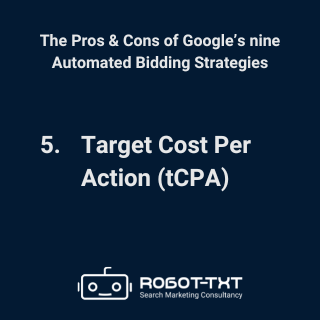
The Target Cost Per Action (or conversion) Google Ads Smart Bidding strategy allows you to set an average cost you’d like to pay for each conversion. When a user does a Google search that fits your product or service, Google Ads uses your Target CPA to set a bid based on the likelihood of a conversion.
Pros of Cost Per Action (tCPA)
• More control over your ad budget
You can set minimum and maximums bid limits to ensure Google doesn’t adjust bids through the floor or ceiling. This will ensure you get the maximum number of conversions for your target CPA.
• Adjust bids by device
If you know that your customers are more inclined to use a certain devices, or historical data has shown that you get more conversions on mobile, for example, you can use the device bid adjustments feature to prioritise conversions for a specific device. You can set adjustments for desktop, tablet, and mobile.
Cons of Cost Per Action (tCPA)
• You need to set up conversion tracking
Like Maximum Conversions and Maximum Conversion Value, Target CPA bidding requires conversion tracking enabled in your Google Ads account.
• You need conversion data
To make smart decisions and drive conversion performance, Google needs to have a certain amount of historical conversion data.
According to Google, the minimum is 15 conversions in the last 30 days at campaign level. However, industry experts’ opinion is that the ideal is closer to 30 to 50 conversions in the past 30 days before testing tCPA bidding.
• Requires a longer period to show results
The Target CPA bidding algorithm needs a certain period to learn in order to optimise effectively. So, if you’re planning a Target CPA campaign, you can expect the algorithm to fine-tune itself during the first two weeks to a month.
• Be careful to set your budget too low
When setting your target cost per action, be mindful not to set it too low. Target CPAs that are too low may cause you to lose out on clicks that could result in conversions, resulting in fewer total conversions. - Target Return on Ad Spend (tROAS)
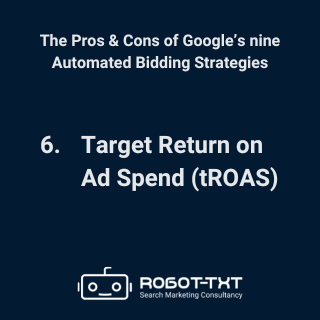
The aim of this Smart Bidding strategy is to increase revenue by achieving a target return on advertising spend. For example, if you want to earn 5$ for every 1$ spend on Google, you would set your target ROAS as 500%.
The bidding strategy works by intelligently predicting the value of a potential conversion, then automatically adjusting your bids for relevant searches to maximise your return on them. This strategy is ideal for eCommerce sites.
Pros of Target Return on Ad Spend (tROAS)
• Guaranteed profits
Using the Target Return On Ad Spend bidding strategy, you know that you will be making sales, so it’s a great way of making sure your ad campaign is profitable and increasing business revenue.
• Measure the value of sales in conversions
Whereas bidding strategies like Maximise Conversions won’t necessarily lead to sales or, more importantly, profitable sales, tROAS guarantees that your advertising spend will be worth it, while allowing you to put your campaigns’ effectiveness down in numbers. You know how much money is coming into your business from your advertising spend.
Cons of Target Return on Ad Spend (tROAS)
• You need conversion data
In order for this bidding strategy to be effective, you need to have sufficient conversion data and a certain sales volume.
• Could potentially prioritise certain products over others
If Google finds, for example that certain products are selling well and getting a great ROAS, it will prioritise those ones – as the aim of this bidding strategy is to get maximum profits. This means the products that don’t yield as big a return might be neglected and won’t sell using tROAS. - Target Impression Share
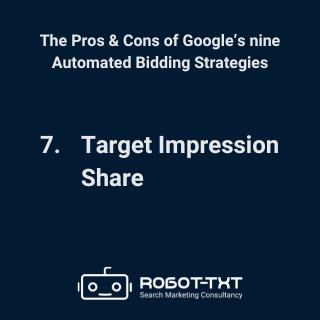
Impression share is the percentage of impressions (views) your Google ads receive compared to the total number of impressions that your ads were eligible to receive. With the Target Impression Share bidding strategy, Google automatically sets bids to help your ads achieve the impression share goal you set for your campaigns.
Pros of Target Impression Share
• Increase brand awareness
If you want to more people to become aware of your business, you can ensure your ad is showing up more often and higher on the search engine results page (SERP) when customers are conducting important searches nearby. It’s a great way of introducing your brand to potential new customers and building brand consideration down the road.
• Set a maximum bid limit
If you want to monitor your budget you can set a maximum CPC bid limit to your maximum bidding.
• Choose how prominently you want your ads to feature
The Target Impression Share strategy has three options for where you want your ads to be displayed: on the absolute top of the SERP, on the top, or anywhere on the page.
• Target by device
You can set mobile bid adjustments to prevent your ad from being displayed on mobile devices.
Cons of Target Impression Share
• Limited coverage
Target Impression Share only includes the Google Search Network and not their Search Partners. - Viewable CPM (vCPM)
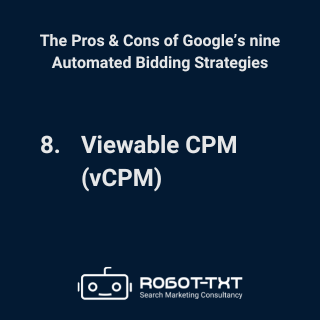
Viewable CPM (vCPM) refers to cost per 1000 viewable impressions. This is a Display-only automated bid strategy designed to let you bid for impressions. To be counted as viewable, 50% of your ad must be shown on screen for one second or longer for Display ads, and two seconds or longer for video ads.
Pros of Viewable CPM
• Increase brand awareness
Viewable CPM is a great automated bidding strategy if you want to expand your brand coverage and get your brand in front of a large group of people.
Cons of Viewable CPM
• Too high frequency can make users feel overwhelmed by your brand
When using this strategy with a very narrowly targeted, niche audience, your chances of hitting a high frequency count for each viewer go up. This means that you’ll be crossing the fine line between memorability and annoyance. - Cost Per View (CPV)
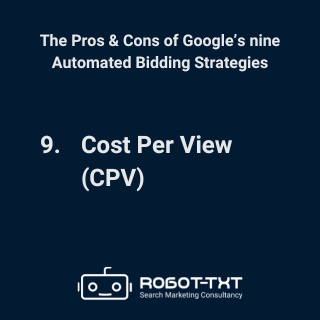
This strategy allows you to bid on individual TrueView video ad views. You set a campaign-level bid limit, which is the maximum you’re willing to pay for each view or interaction with your video, whichever comes first.
A view is charged if someone watched your video for more than 30 seconds (or if it’s shorter than 30 seconds, watches the entire video). If the viewer clicks on a link or takes part in other calls to actions, like an app download, for example, it will also be charged for that interaction.
Pros of Cost Per View
• Relatively cheap
The average cost per video view tends to be relatively cheap, which makes CPV a great strategy for hyper-focused video campaigns in a highly competitive space.
• For brand awareness and performance
Traditionally, CPV ad campaigns were used for brand awareness. However, advertisers with performance goals, such as app downloads, are increasingly buying ads on a CPV basis.
Cons of Cost Per View
• Targeting must be done with precision
If you target your video campaigns too broadly, you run the risk of getting views that won’t add valued. You may bring in thousands of views at a cheaper cost, but if you’re not in front of the right audience, it won’t make sense.
Conclusion
Automated bidding is a useful tool when it comes to managing and optimising your PPC campaigns. That being said, there are a number of factors you need to consider in choosing the right bidding strategy. Whether you want to increase brand awareness, generate quality B2B leads or increase revenue, our team can help you skyrocket your PPC results.
If you want to know which strategy is best suited to your business objectives, reach out. We specialise in high-impact, cost-effective PPC packages for small businesses and large enterprises. We can help you establish dominance for industry-related keywords and get your business in front of the right audience.
